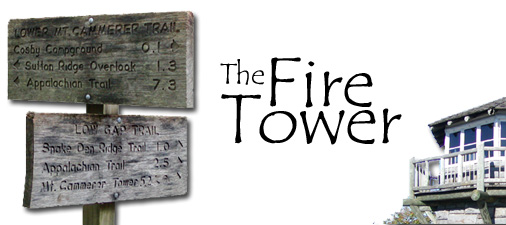


 
 
 

Well-deserved winner of the "Best of Show" award in the 2004 IF Art Show competition, The Fire Tower is a captivating all-text "virtual hike" that offers evocative landscape, realistic locations, and extremely well-written descriptions.- The Underdogs 
The Fire Tower is my first and, unfortunately, my only real 'full-scale' game release.Submitted to the 2004 IF Art Show in the Landscape category, this game explores a hike to the Mt. Cammerer Fire Tower in the Great Smoky Mountains National Park. I was both suprised and pleased to see it take Best of Show in that competition, and was very pleasantly surprised, to say the least, when it took the 2004 Xyzzy for Best Setting, and when it was featured as part of Aaron Reed's 50 Years of Text Games.
You can play the game online in your browser by clicking here. If you'd prefer to play offline, you can download The Fire Tower by clicking here, and either way, there's a map for the game here.If you're new to interactive fiction, I would recommend a visit to A Beginner's Guide to Playing Interactive Fiction before you download anything.
 Reviews for The Fire Tower Reviews for The Fire Tower
J. D. Berry:Fire Tower takes the rope, guides it on a spinning wheel, and produces gold. Unlike Rumplestiltskin, no magic was used. It just seems that way. Fire Tower is what happens when love and skill come together. Love for the environment represented and the medium in which it's presented. Skill in knowing the environment and conveying that in writing. Fire Tower's setting is the most authentically represented that I've seen in a work of IF. Authenticity permeates this work on all levels. I like how this has the "Cove" (The 2000 IF Art Show entry) touch-the eye for bringing the little things in perspective while harmonizing with the big. You see the panorama while being in the diorama. Also like "Cove", it evokes emotion and breathes life into its surroundings. Fire Tower guides you without forcing you. I was about to write, "it is this aspect of Fire Tower that makes the piece work" (and, in fact, I did), but I realized this is only one of its many fine points. The balance between the necessity of getting back to the parking lot before dark and the desire to stop and smell the flowers is maintained throughout. I think the slight time pressure (in the immediate sense, and yet also in our human lives (there will be no further unintended extrapolations for the remainder of this review)) added more meaning to my actions.I love the many wonderful responses to sense commands.Play this. Experience it.
Emily ShortThis is excellent. "Firetower" is an IF hike through the mountains of Tennessee, gorgeously done.The author mentions in her notes that this area is one of her favorite spots, and it shows. The setting is acutely observed and described, with responses for every sense. They're not just perfunctory responses, either: I was left with a very clear impression of the flora in this area, and a somewhat more fleeting idea of the fauna. The only place I recall seeing quite such a thorough natural setting was in "She's Got a Thing For A Spring" (Brent VanFossen, 1997), though for whatever reason "The Fire Tower" worked better for me than "Spring" -- possibly because, without puzzles to worry about, I was in a better position to enjoy the natural surroundings. The meticulous implementation applies elsewhere as well. The piece anticipates many nonstandard actions -- I was particularly amused by the response to my attempts to turn the signposts."Firetower" also gives a strong sense of continuity of space and time. There are transitional descriptions between locations that let you know how far you've gone, over what kind of terrain, and what you saw on the way. When you have travelled far, considerable time elapses on your watch. Meanwhile, the sun rises and sets in the sky; the quality of the air changes; shadows lengthen; campers wake up, are active, and go to bed. If you emerge from the woods late enough, you even get a telling-off from the person who's there to pick you up.The PC is well-formed, too. The responses to trying to taste various plants, for instance, or pick things that you shouldn't pick, are met with very park-rangerly replies -- knowledgeable, but concerned with safety and the preservation of the wildlife. But the characterization isn't just there to preach good park behavior: the PC feels like a specific person. She sings Stevie Nicks to herself, eats the best bits out of her trailmix first, and doesn't panic when meeting a bear. Her pleasant, down-to-earth attitude affects almost every descriptive passage.
Jon IngoldA day's hiking in the Great Smoky National Park. Trails run along mountainsides, dotted with a fine array of wild flowers and the occasional stunning vista. Not perhaps the most obvious idea for a game, as long walks are usually affairs of little incidence and less manipulations. Some bits and bobs are provided for players who need things to fiddle with (a kit bag, a bottle of water) but they're largely superfluous - we are instead expected to enjoy rambling for its own sake. This quickly charmed me; I think because of the game's unassuming air - there are no ghosts of dead backpackers thrown in to spice things up: this is straightforward in its depiction of a landscape the author (or, at least, the character) clearly loves. That enthusiasm comes through cleanly, uncluttered by desires for gimmicks appealling to an audience's affections, and yet at the same time the game reveals itself in snatches to be extremely well built. Examples: my feet, implemented as body parts that follow me around but don't appear in an inventory. There is a watch that keeps track of time both move by move, and in the long stretches between points of interest. Above all, there's a fair amount of placement to the text - passages that appear only once, messages that don't repeat.
Adam ThorntonThis is probably my favorite of the Art Show. A *whole lot* is implemented. You can't--at least I couldn't--make your character do anything REALLY stupid, but you can stay out too late and get the park ranger to come for you (kids, don't try this at home. I'm in a Search and Rescue Unit, and finding dumbasses lost in the woods when nothing is really wrong with them, except that they're inconsiderate jackasses, isn't much fun). It's not as buggy and itchy and painful as I generally find hiking trips to be but maybe that's just because I'm not really all that into the camping/hiking thing. Now that I've crossed the Continental Divide in the Bob Marshall Wilderness, I don't have to prove anything anymore and I can stay between nice clean sheets in air-conditioned motel rooms, TYVM. Anyway, extremely well written, lots and lots of detail, almost everything I thought to try was implemented. Very, very well done. It almost makes me want to go on a hike with Jacqueline, except that I know that the Alaskan mosquitos would carry me away.
Mike Penman
This review originallyappeared in SPAG Writing for the IF Art Show isn't easy, I know. Faced with the remit "explore interactivity", where do you begin?Jacqueline A. Lott chose to begin with an engaging character. The protagonist of The Fire Tower is consistently drawn, from the results of ">look at me", ("You glance down and the first thing you see are your hiking boots. They're serious hiking boots...") to knowledgeable asides made during the IF. She even has a purpose, having come to the fringes of Mount Cammerer in the Appalachians to walk solo and get away "from everything: work, responsibilities..."Though it was good to find such a well-presented character, it's Mount Cammerer that stars in this piece. This was an entry in the 2004 IF Art Show "landscape" section. It took best of show and "best setting" at the following XYZZYs.The first, powerful impact is of a beautiful landscape beautifully presented. It's tempting to describe sweeping scenes with flowery prose but the author resists that temptation. The text is sparse and transparent; it doesn't get in the way of the country depicted and everything is described with an infectious enthusiasm. I was left feeling relaxed, as though I'd been there, at least in part. I presume that was the main objective of the piece, so it's a success from the first play through.That sense of "being there" is enhanced by the sheer interactivity of the piece. Faced with something that says, in essence, "See how interactive I am!" I start to verb the nouns. This setting is deeply implemented. Almost everything can be examined, heard, smelled, felt and tasted. I know more about Appalachian flora now than I did before playing.Sometimes a lack of options left me feeling frustrated. I wanted to go back on myself or try routes that I wasn't allowed to. I was particularly miffed to find that I missed the work's titular tower because, having moved away from it without entering in order to re-check a previous description, I was barred from returning. But this isn't a game -- the author's trying to guide the player around a landscape -- nor would route reversals or unplanned diversions be in character for the experienced lone-walker protagonist.Time -- always a difficult dimension in landscape -- is well handled. The protagonist's watch counts one minute for each turn and each travel description adds a number of minutes dependent on the terrain covered. There's a sense of time passing at a realistic rate, adding to the sense of "being there".I was disappointed with the centre of the game, the fire tower. It being the target and title of my walk, I was looking forward to finding something extra there. It's as beautifully described as everything else, but I'm not sure it deserves its pivotal placement.It's a good sign if the only major gripe I can raise about an IF is that I was left wanting more. In particular I wanted to explore the issues of stilting and entrapment -- barely but skillfully hinted at -- that led to this walk in the first place. I wanted to turn the protagonist to an equipment shop and then along the whole Appalachian trail, fulfilling her lifetime dream. For a player like me, without any real interest in puzzles, it wouldn't take much to turn this into a full length game in the Sunset Over Savannah mode.Perhaps the best praise I can offer the piece is this: I wish I'd written it. Its clean, artless-seeming approach fosters the illusion that I could have. In fact, I think I feel a landscape entry for next year's IF Art Show coming on. But first I'm going back to see if I can find the bear that Emily Short saw.
[ TOP OF THIS PAGE | MORE IF | HOME ]


|






